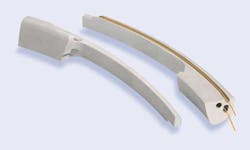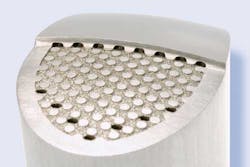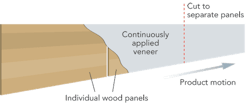Reducing cycle time by LaserCUSING
Kortrijk, Belgium – Vlaams Plastics Centre, a service company based here, employs a team of experts from the plastics sector, each having 30 years of experience in his or her specialist field. The main aim of the Centre is to gather knowledge in the field of plastics processing and to use this knowledge to provide information and advice to plastics-processing companies.
Plastic injection molding is a highly competitive business and mold tool design influences not only quality and cycle times but ultimately production output and profit. One area of the injection molding process that has a significant impact on the overall cycle is the time required for cooling, prior to the finished component being ejected from the mold tool. It is clear, therefore, that finding ways to reduce the cooling cycle, while maintaining or even improving product quality, is a prime target for mold tool designers.
FIGURE 2. The close-contour cooling of many individual loops which in a parallel connection open into large access and outflow bores.
The use of LaserCUSING® technology, a process from the field of rapid tooling / prototyping / manufacturing, offers tool and mold makers the option of producing mold inserts with individually configured close-contour cooling channels in the space of just a few days.
The close-contour cooling may consist, for example, of an individual cooling channel (FIGURE 1), of many individual loops, which in a parallel connection open into large access and outflow bores (FIGURE 2) or of a cooling surface with a mesh structure (FIGURE 3). The advantage of LaserCUSING is the individual design of the cooling channels that can be tailored for the specific component. The process enables cooling channels to be designed and created which run close to the contour or surface of the mold insert, providing much greater control of cooling and the ability to guarantee uniform temperature distribution during cooling.
Conformal cooling
The specialists at Vlaams were already aware of LaserCUSING and the benefits that it can bring to the injection molding process through the creation of conformal cooling channels in mold tool inserts. However, according to Mr. van Hoye, head of the team of experts, it became apparent that it is difficult to convince mold tool manufacturers and plastics processors of the advantages without presenting a realistic demonstration of the capabilities of the process. For the Vlaams Plastics Centre, this provided the impetus to carry out a study comparing the influence of four different mold tool inserts in the injection-molding of a plastic part.
This extensive study compared the cycle time required to achieve a targeted de-mold temperature using mold tool inserts produced in different materials by conventional machining methods, with a conformally cooled insert produced using the LaserCUSING process. These tests were also conducted using two different polymers, PP (polypropylene) and ASA (acrylic ester-styrene-acrylonitrile).
Additional objectives of this study centered around the amount of bending on the component following complete cooling and also the level of distortion present within a "U-profile" in the part. The results of the study served to confirm the initial views of the experts at Vlaams Plastics Centre that the insert produced by LaserCUSING would bring significant benefits. The cycle time required to achieve the targeted de-mold temperature of 65 degrees was just 24 seconds with the LaserCUSING insert compared to 31 seconds with a conventional steel insert, a saving of 7.0 seconds or 20%. This result was consistent across the two different polymers tested.
The results of the bending/warping investigations after complete cooling indicated that the LaserCUSING plastic part bent by ~4.5 mm. The part produced with the conventional steel insert bent, under the same conditions, by a whole 7 mm, which equates to a difference of 36% in favor of the parts produced by LaserCUSING. The specification laid down for deformation required there to be no more than 1 mm. In the case of the plastic part produced with the conventional steel insert, this was achieved with a cooling cycle time of 50 seconds. By comparison, the part produced using the LaserCUSING insert meets this requirement with a cooling cycle time of just 27 seconds. This means a deformation that meets the 1 mm maximum specification with half the cycle time when compared to the conventional steel insert.
FIGURE 3. The close-contour cooling of a cooling surface with a mesh structure.
With definitive results such as this, mold tool inserts manufactured by the LaserCUSING process and incorporating conformal cooling channels look set to become an integral and indispensable part of mold tool design in the future.
For further information, contact [email protected] or go to www.estechnology.co.uk.
Lasers speed furniture manufacturing
East Westphalia, Germany – Rudolf Henrichsmeyer Formaplan GmbH & Co. KG is a volume manufacturer of furniture parts, drawers, and flat-pack furniture. Drawers, one of the company's main product lines, are produced as individual sides and backs, which are then assembled by the buyer.
Drawer sides start as individual 12 mm thick chipboard panels with widths varying from 60 mm to 300 mm and lengths between 300 mm to 750 mm. These individual parts are then wrapped with a thin (<0.5 mm) plastic foil in a continuous process. The pre-cut wood panels are fed in end-to-end, and the foil is applied so that a continuous length of foil profiles is produced. The foil must then be cut through completely so as to again separate the individual profiles. These are then trimmed to final size, and any necessary holes, grooves or other features are added.
The panels move through the machinery at high speed rates, and the foil is applied and cut without interrupting this continuous motion. In the past, Formaplan accomplished this cutting with a complex system using mechanical saw blades cutting in a direction perpendicular to the part motion. But the fast part motion meant that the saw blade also had to simultaneously move parallel with product flow. After each cut, the blade returned to its original position.
The equipment that produces this rapid motion for a relatively heavy saw blade (5 mm thick) was expensive and complex. Major service for this machinery was required every three months. And, perhaps most importantly, the speed of this mechanical sawing process represented a rate-limiting bottleneck in panel production, which in turn limited Formaplan's ability to lower process costs.
The company has now switched to a system that utilizes two Coherent Diamond 400 W average power CO Formaplan selected the Diamond E-400 laser for this application for its excellent beam quality. The physical size of the wood profiles, together with the distance over which they must be scanned as they travel, necessitates the use of relatively long focal length focusing optics. As a result, the spot size on the cutting surface is relatively large (in the 200 µm to 300 µm range). But the need to cut rapidly in order to sustain the desired throughput means that the dwell time at a particular point is fairly short. The high quality mode of this laser puts sufficient power in the beam center to reach the threshold processing intensity, even with the large spot size, and thus enables rapid scanning. The E-400 based system has supported an increase in line speeds of up to 35%, cutting production costs for these panels. Mechanical sawing produced a wide cut with a relatively poor quality edge; additional cutting was then needed to remove this unsightly edge, as well as to render the part into its desired final size. In contrast, the laser makes a much smaller cut, and the high mode quality and fast rise time with a smaller heat affected zone. As a result, much less material is removed when the part is cut to its final size, thus reducing product wastage. The switch from saw cutting to laser processing has proven to be a profitable move for furniture maker Formaplan. The capital cost of the laser system is only slightly more than the mechanical saw based equipment, yet it requires major maintenance only every four years, rather than every three months. When combined with increased process speed and reduced waste, the return on investment of laser cutting is quite substantial. Contact Frank Gaebler at Coherent Inc. at [email protected].
Past ILS Issues




